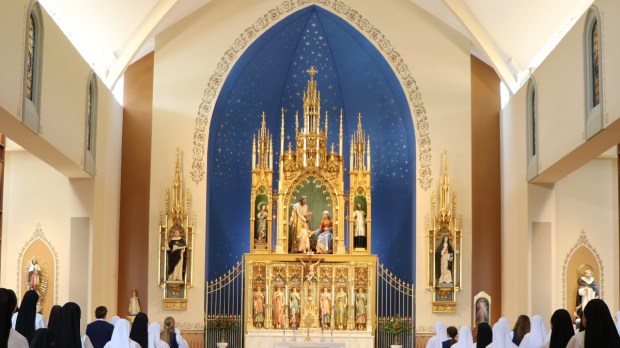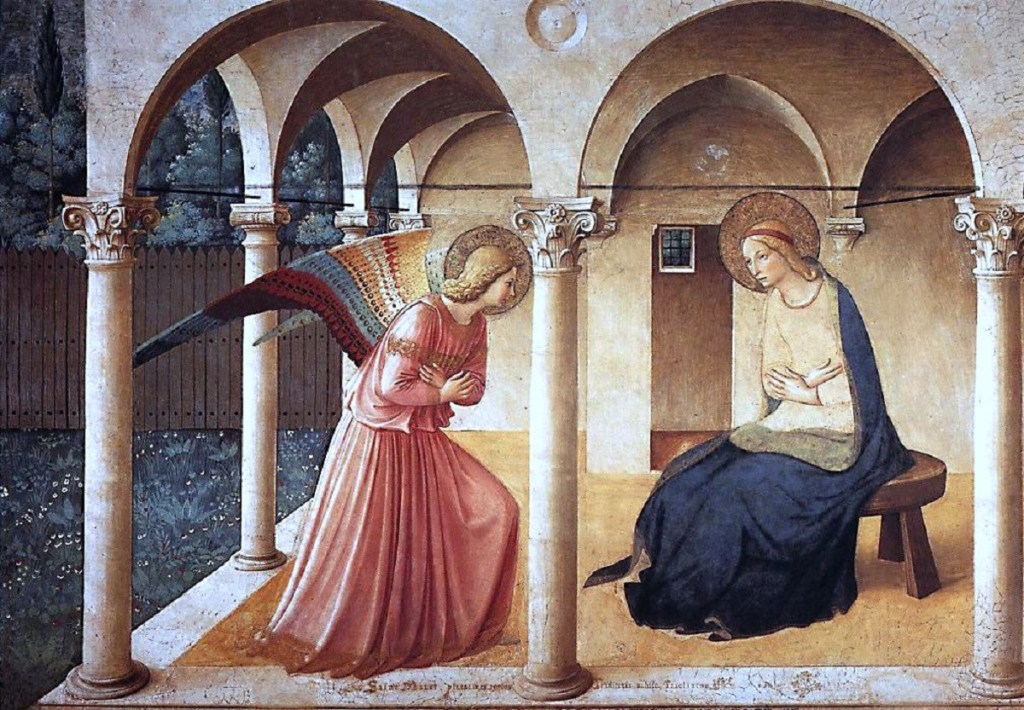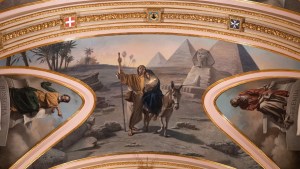After encountering some severely simple convent and monastery chapels, I asked friends in the architecture world to suggest material that would contradict the cheap chapel change mindset. Two of the books suggested were Stones Laid Before the Lord: Architecture and Monastic Life, by Anselme Dimier, and Religious Poverty, Visual Riches by Joanna Cannon.
One of the architect-friends, however, summed it up in two paragraphs. I had been expecting a book with quotes from artistic and saintly souls (such as Catherine of Bologna, a Poor Clare, as well as Fra Angelico and Venerable Samuel Mazzuchelli, both Dominicans) who, despite their own freely-chosen personal poverty, enthusiastically emphasized the eternal value of sacred art.
What I got was this eagle-eyed observation that may help to qualify my friend for the artist-saint category:
The history of the architecture of religious orders until the emergence of modernism is replete with counter-examples to this [cheap chapel] attitude, whether for mendicant orders or otherwise. What examples we have of stark religious architecture are often the result of being unfinished or a prior finish later destroyed.
Even where noble simplicity was the stated aim of a religious community, the minimalism extolled today as its purported heir stands as much in contrast to that humble aesthetic as the machine does to nature. Even “Cistercian simplicity” before modernism ranges from the dressed and hand-carved stone of the Romanesque to the ecstatic flights of the Rococo in ways that render the term “simple” anachronistic when used today to refer to those earlier eras as somehow identical or even analogous to the “simplicity” now championed.
Some communities appear to be laboring under the assumption that sacred art is an impediment to union with God. This might seem like a supremely noble pursuit of perfection, but it is actually an anti-Incarnational misconception. Even one of the top mystics of the Church fell prey to it before being set free.
Holy steeple, holy people
In The Passion and Death of Jesus Christ, St. Alphonsus Liguori recounts a story about St. Teresa of Avila, saying that she “complained of certain books which had taught her to leave off meditating on the Passion of Jesus Christ, because this might be an impediment to the contemplation of his divinity.” He continued, writing that St. Teresa exclaimed:
O Lord of my soul! O my Jesus crucified, my treasure! I never remember this [iconoclastic] opinion without thinking that I have been guilty of great treachery. And is it possible that You, my Lord, could be an obstacle to me in the way of a greater good? Whence, then, do all good things come to me, but from You?
How can this be remembered and lived out when crucifixes or the Stations of the Cross are so small, colorless, or vague that they are nearly or totally unidentifiable? The purpose of sacred art is not to satisfy a bare-minimum church checklist, but to help us enter into the reality of the Incarnation via the sacred humanity of the Lord.
Embarking on beauty
There are many resources explaining why chapels should be beautiful—including the Bible (such as Jacob’s dream of the house of God at Bethel Genesis 28), St. John Damascene (a monk who strongly defended the value of sacred art), the Second Council of Nicaea (which repudiated the heresy of iconoclasm), and the Catechism of the Catholic Church (which stated in the explanation of the Commandment about not bearing false witness that genuine sacred art draws us to the adoration and love of God).
These resources, along with images showing how magnificently chapels can glorify the Lord and sanctify worshipers, should be enough to ignite the spirit of the Transfiguration within religious communities. A charitable and cheerful challenge is hereby extended to our cheap chapel chums to add identifiable and colorful stations, statues, mosaics, paintings, and other decor as part of their sacred art.
Because real artists are needed for this beautification, it is worth mentioning that Daprato Rigali Studios (whose work can be seen in the image of the Ann Arbor chapel of the Dominican Sisters of Mary, Mother of the Eucharist), Conrad Schmitt Studios, Ever Greene Architectural Arts, and John Canning Company are four of the best-known groups that can help chapels change back to the ways of the Church.
St. Catherine of Bologna, Blessed Fra Angelico, Venerable Samuel Mazzuchelli and all artistic-saintly souls, pray for us to better understand how to employ material means to attain greater union with the goodness, truth and beauty found in the Almighty God who became a man in the Incarnation, whose beginning we celebrated last week on the Annunciation (March 25).




